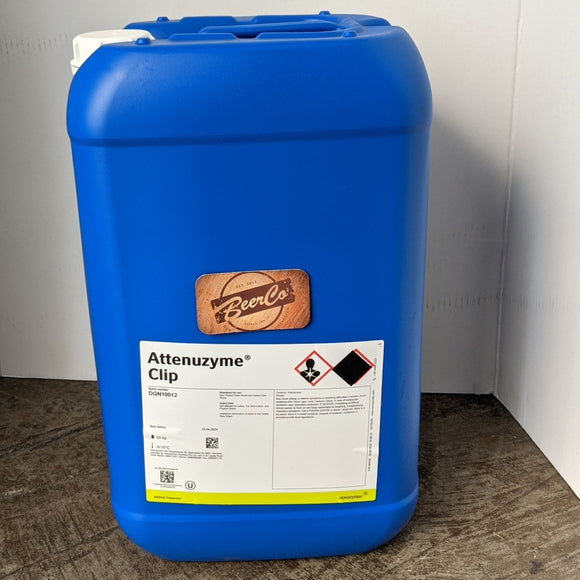Novozymes Attenuzyme® Clip is a heat-stable solution to achieve adjustments in real degree of fermentation (RDF) for attenuated beers.
Attenuzyme® Clip is a pullulanase that accelerates attenuation. You can use it to get a moderate increase in the attenuation of maltose-based wort.
In this product the key enzyme activity is provided by pullulanase that hydrolyzes (1,6)-alpha-D-glucosidic linkages in pullulan, amylopectin and glycogen.
Key Benefits:
- Achieve desired attenuation
This product delivers predictable and targeted real degree of fermentation (RDF). It helps you to control the percentage of fermentable sugars you derive from starch. It allows you to increase fermentable sugars or maintain them at a specific level so you can achieve your desired attenuation.
- Accelerate fermentation
By releasing more fermentable sugars in the brewhouse, this product supports the need to accelerate your fermentation times.
- Increase brewhouse capacity
This fast-acting product shortens mashing times. That allows you to increase brewhouse capacity while saving time and energy.
PRODUCT CHARACTERISTICS/PROPERTIES
Component name: Pullulanase
Activity: 400 PUN-J/g
Side activities: The product contains controlled activity of Alpha-amylase
Color: Yellow to light brown
Physical form: Liquid
How pullulanase enzymes help control attenuation in brewing
Pullulanases are de-branching enzymes. Brewers use them on their own to achieve small attenuation adjustments via maltose formation. They're also combined with glucoamylases and/or α-amylases to speed up starch breakdown. That allows for shorter conversion times or lower glucoamylase dosage.
Pullulanases are de-branching enzymes. They cleave α-1,6-glucosidic bonds in amylopectin. They're just one of the enzyme classes used to control the degree to which sugars in the wort are fermented into alcohol. Getting attenuation right is about balancing enzyme class, dosage and conversion conditions.
Pullulanases work in synergy with malt β-amylase. That means brewers can use them on their own for small attenuation adjustments via maltose formation.
Working in combination with glucoamylases and/or α-amylases, pullulanases speed up starch breakdown. Brewers can use these combinations to reach attenuation targets in shorter conversion times. They can also choose to use them to lower glucoamylase dosage.
pH and temperature curves
Attenuation enzymes can be used in the brewhouse or possibly during fermentation.
The degree of attenuation desired is governed by the choice of attenuation enzyme (glucoamylase, α-amylase, pullulanase or combination), enzyme stability (temperature and pH), enzyme dosage, conversion temperature and conversion time.
When choosing an enzyme solution for attenuation control, it is important to look at the activity curves for each based on temperature and pH. Select an enzyme solution that has significant activity and stability where you want to use it – in either mashing or fermentation.
Fig. 6.4-1 illustrates the temperature and pH activity curves for Novozymes' attenuation enzymes. It is clear that from a pH point of view, all enzymes have significant activity in the typical pH ranges encountered during brewing. From a temperature perspective, Attenuzyme Core (and Attenuzyme Pro) and AMG 300L BrewQ have high activity between 60°C and 70°C and would be more suitable for mashing application than Fungamyl BrewQ, which undergoes significant denaturation in this temperature range. Therefore, Fungamyl BrewQ may be of more use in fermentation applications.

Usage

More information can be found in the “Brewing Handbook”.
Stability
Please see the Attenuzyme® Clip - Product Data Sheet
Safety, handling and storage
Recommended storage: 0-10 °C (32-50 °F) Packaging must be kept intact, dry, and away from sunlight. Please follow the recommendations and use the product before the best-before date to avoid the need for a higher dosage.
Best before: You will find the best-before date in the certificate of analysis or on the product label. The product gives optimal performance when stored as recommended
and used prior to the best-before date.


